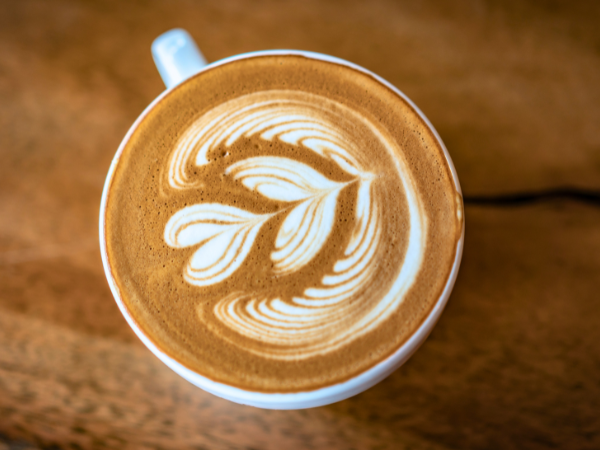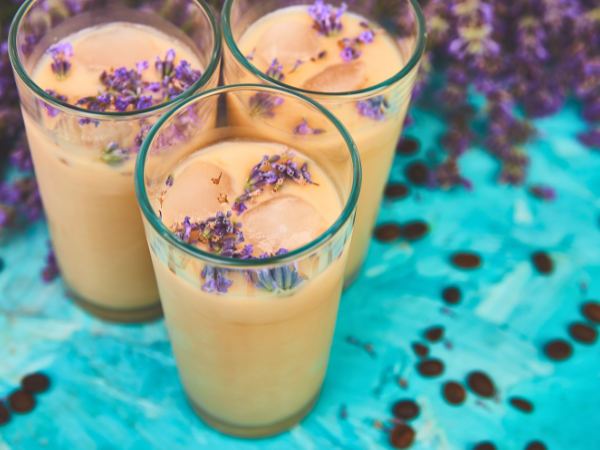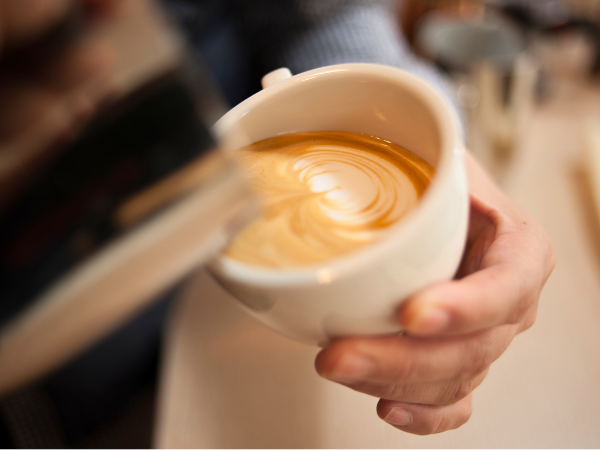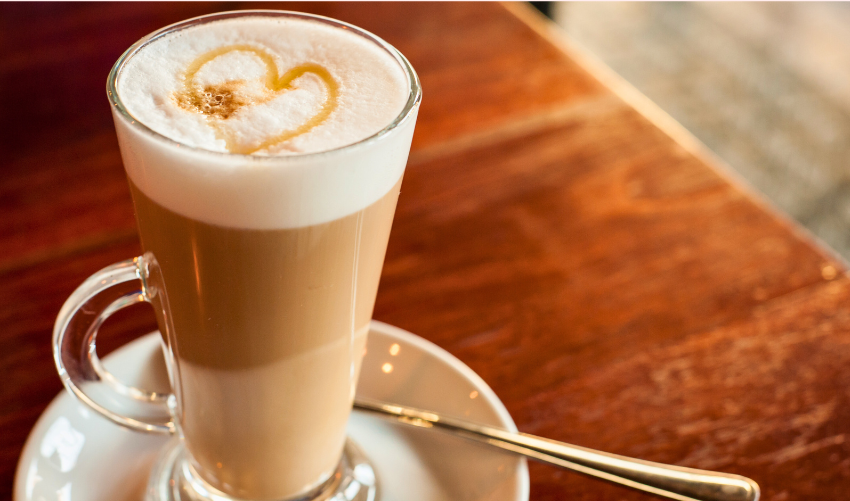The latte is more than just a popular coffeehouse staple — it’s a blend of rich espresso and creamy steamed milk that’s been enjoyed for generations.
In this guide, we’ll explore everything about the beloved latte — from its origin story to popular variations, caffeine content, and how to make it at home.
What Is A Latte? The Beloved Coffee & Milk Classic
Simple origins define the latte. At its core, a latte is an espresso-based drink made with steamed milk and a thin layer of foam. The combination creates a perfect balance of flavors.
The latte is known for its high milk-to-espresso ratio. This ratio creates a smooth and creamy texture, appealing to many coffee drinkers. Here are some key elements:
- Espresso Shot(s): Provides the coffee base – flavor and caffeine kick.
- Steamed Milk: Adds sweetness and body – creating a velvety texture.
- Microfoam: A thin layer of delicate, aerated milk on top – often used for latte art.
Globally, the latte enjoys immense popularity. It is a staple in coffee shops worldwide. Many enjoy it for its approachable flavor. Whether you like it plain or with flavor syrups, the latte satisfies a wide range of tastes.
Key Components Of A Perfect Latte
Creating a perfect latte involves understanding its key components. Each element plays a crucial role in the overall experience.
Here’s a breakdown of what makes a latte exceptional:
| Component | Purpose |
|---|---|
| Espresso | Provides the rich coffee flavor and caffeine boost. |
| Steamed Milk | Enhances sweetness and adds creaminess. |
| Microfoam | Creates a light texture and allows for latte art. |
Each step matters. Perfecting these components results in a delightful drink. Enjoying a latte becomes a ritual, bringing comfort and joy.
Rich History Latte Origins

The story of the latte starts in Italy, where it is known as “Caffè Latte.” Originally, it was a simple breakfast drink enjoyed by families. The drink combined coffee and milk, creating a comforting start to the day. Here are key points in the latte’s journey:
- Italian Beginnings: Caffè Latte was a staple in Italian households.
- Post-WWII Evolution: After the war, espresso culture flourished in Italy.
- US Popularity: The drink gained fame in the US, especially in Seattle.
- Rise of Specialty Coffee: The latte evolved into a sophisticated café beverage.
The growth of espresso culture in the United States drove the latte’s popularity. Coffee shops began to serve lattes with a twist, introducing flavors and fancier presentations.
| Era | Latte Development |
|---|---|
| 1950s | Started as a breakfast drink in Italy. |
| 1980s | Baristas experimented with milk pouring techniques. |
| 2000s | Latte art became a sign of skill in cafes. |
The latte’s journey reflects its evolution from a simple drink to a global icon. Today, it is recognized everywhere, loved for both its taste and presentation.
The Evolution Of Latte Art
Latte art has become a significant part of the coffee culture. Baristas started experimenting with pouring milk in the 1980s. This led to the creation of beautiful patterns on lattes, enhancing the drinking experience. Here are some important aspects of latte art:
- Early Techniques: Baristas began to create designs in the late 20th century.
- Global Phenomenon: Latte art spread to coffee shops worldwide.
- Aesthetic Appeal: Visually appealing drinks enhance customer enjoyment.
Latte art transformed the way people view coffee. It is no longer just about taste. The visual presentation adds to the overall experience. Popular designs include:
- Hearts
- Rosettas
- Swans
Many coffee lovers seek out cafes known for their latte art. This artistic expression showcases the barista’s skill and dedication. As a result, latte art has become a symbol of quality in coffee shops.
Exploring Latte Types: Beyond The Classic Variations

Flavor-infused lattes add a delicious twist to the classic recipe. They often include syrups or spices, enhancing the taste experience. Here are some popular flavored lattes:
- Vanilla Latte: The most popular flavored latte, using vanilla syrup.
- Caramel Latte: Features rich caramel syrup, often with a drizzle on top for added indulgence.
- Seasonal & Specialty Lattes: Includes unique flavors like pumpkin spice, peppermint, or lavender lattes.
- Hazelnut Latte: It features a sweet and nutty flavor profile.
Flavor-infused lattes cater to those seeking something different. Each sip brings a burst of flavor, making them a favorite for many coffee drinkers.
Tea-Based & Non-coffee Lattes
Tea-based lattes are a wonderful alternative for non-coffee drinkers. These lattes use tea instead of espresso. They offer unique flavors and a comforting experience. Here are some popular tea-based lattes:
- Chai Latte: A spicy-sweet latte made with concentrated chai tea and steamed milk.
- Matcha Latte: Utilizes vibrant green tea powder, offering an earthy flavor and sustained energy.
- Turmeric/Golden Latte: Health-focused options made with spices like turmeric, ginger, and non-dairy milk.
Tea-based lattes offer comfort and flavor. They can be enjoyed hot or cold, making them versatile options.
Modern & Innovative Latte Styles
The coffee world constantly evolves, introducing modern and innovative latte styles. These new creations bring fresh experiences to coffee enthusiasts. Here are some popular modern latte styles:
- Iced Latte: A refreshing cold version, often made by pouring espresso and milk over ice.
- Nitro Latte: Cold brew coffee infused with nitrogen for a creamy, cascading effect.
- Blended/Frozen Lattes: Coffee or tea blended with ice, milk, and flavors for a smoothie-like texture.
Modern lattes are perfect for those seeking new flavors or a refreshing drink. They showcase creativity in the coffee world.
Crafting & Enjoying The Latte Experience: Recipes & Techniques

Crafting and enjoying the latte experience involves more than just pouring coffee and milk. It’s about finding the right ingredients and techniques to create a delicious drink.
Best Coffee Beans For Lattes
Choosing the right coffee beans is essential for a great latte. Medium to dark roasts are preferred. These roasts typically offer bolder, more developed flavors like chocolate, caramel, and nuts.
Consider the type of coffee bean:
- Arabica: Offers complex and smoother flavors.
- Robusta: Has a stronger, earthier taste.
A blend of both can enhance your latte. While 100% Arabica offers smoothness, blends with a small percentage of Robusta can create richer crema and a fuller body.
Essential Latte Equipment
To craft the perfect latte, having the right equipment is crucial. Here are the must-have tools:
- Espresso Machine: Required for brewing espresso shots at home.
- Milk Frother: An electric frother or steam wand creates creamy foam.
- Latte Mugs: Wide-mouthed mugs are ideal for serving and showcasing latte art.
Investing in quality equipment makes a noticeable difference. It enhances the overall latte experience and makes it enjoyable.
Popular Latte Recipes To Try
Creating lattes at home can be fun. Here are some popular recipes to try:
- Classic Vanilla Bean Latte: A sweet and creamy latte with vanilla flavor.
- Spiced Fall Pumpkin Latte: A seasonal favorite with pumpkin spice.
- Creamy Iced Caramel Macchiato: A refreshing iced treat with caramel drizzle.
Experiment with different flavors and techniques. Enjoy the process of making your favorite latte at home!
Latte Nutrition: Caffeine Content, Calories, And Health Considerations
This drink is not just popular for its creamy texture and delicious flavor but also for its nutritional aspects. Understanding the latte’s nutrition involves looking at its caffeine content, calorie count, and health considerations.
Caffeine Content In Lattes
The caffeine content in lattes varies based on the number of espresso shots used. A typical latte contains about 75-150 mg of caffeine, derived from one or two espresso shots. Here’s a quick breakdown:
- Standard Espresso Base: Each shot of espresso has about 63 mg of caffeine.
- Decaf Options: Available with decaffeinated espresso for those avoiding caffeine.
- Tea-Based Variation: Chai or Matcha lattes have varying caffeine levels, depending on their tea components.
Here is a simple table showing the caffeine content in different types of lattes:
| Type of Latte | Caffeine Content (mg) |
|---|---|
| Regular Latte | 75-150 |
| Decaf Latte | 5-15 |
| Chai Latte | 50-70 |
| Matcha Latte | 70-100 |
Understanding the caffeine content helps you choose your latte wisely, especially if you’re sensitive to caffeine.
Calorie & Macronutrient Breakdown
Calories in a latte depend on the milk choice and any added flavorings. Whole milk lattes are higher in calories and fat, while skim or non-dairy options reduce these numbers. Here’s a simple overview:
- Whole Milk Latte: Approximately 200-300 calories.
- Skim Milk Latte: About 100-150 calories.
- Dairy-Free Alternatives: Oat, almond, soy, or coconut milk can vary greatly in calories.
Moreover, sweeteners play a significant role:
- Sweetener Contribution: Syrups and added sugars significantly increase calorie and carbohydrate counts.
- Flavoring Additions: Whipped cream and sauces can substantially boost total calories.
- Sugar-Free Options: Use sugar-free syrups and skip added sugars to reduce calorie and sugar intake.
Here is a table showing the calorie breakdown of different latte variations:
| Type of Latte | Calories |
|---|---|
| Whole Milk Latte | 200-300 |
| Skim Milk Latte | 100-150 |
| Oat Milk Latte | 150-250 |
| Flavored Latte (with syrup) | 300+ |
Choosing the right milk and monitoring additions can help control your calorie intake.
Health And Dietary Adjustments
For health-conscious individuals, lattes can fit into various dietary plans with some adjustments. Consider these tips:
- Mindful Indulgence: Enjoy specialty lattes as an occasional treat rather than a daily staple for dietary balance.
- Milk Choice Impact: Opt for skim or non-dairy options to cut back on calories and fat.
- Sweetener Choices: Choose natural sweeteners or sugar-free syrups to reduce sugar intake.
People with lactose intolerance can explore dairy-free alternatives like:
- Oat milk
- Almond milk
- Soy milk
- Coconut milk
Each of these options offers a unique flavor and nutritional profile. Making informed choices about your latte can support your health while still allowing you to enjoy this coffee classic.
